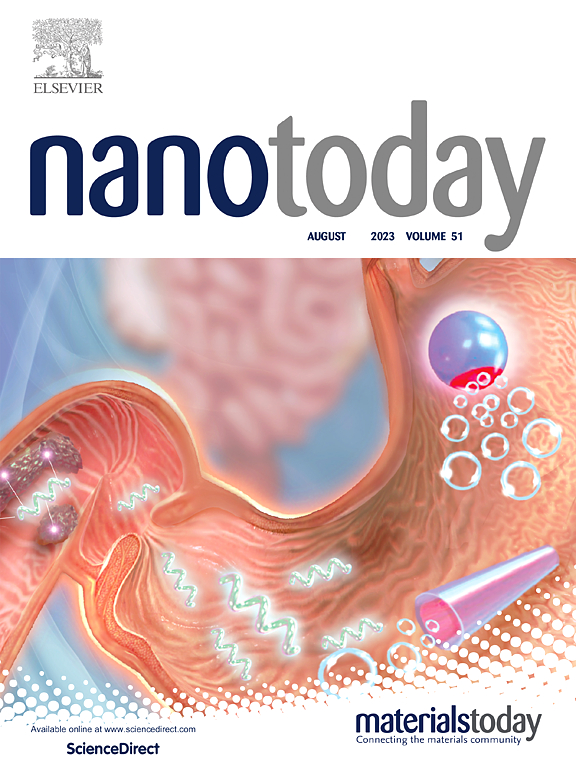gsh反应性纳米颗粒通过抑制DNA损伤修复途径和激活cGAS-STING途径增强卵巢癌化学免疫治疗
IF 10.9
1区 材料科学
Q1 CHEMISTRY, MULTIDISCIPLINARY
引用次数: 0
摘要
卵巢癌,特别是耐药亚型,治疗反应率低于30% %,主要是由于DNA损伤修复机制的增强降低了化疗的疗效。此外,卵巢肿瘤中低水平的免疫细胞浸润限制了免疫检查点抑制剂(ICIs)的治疗反应。解决化疗耐药和免疫激活对改善预后至关重要。DNA依赖性蛋白激酶催化亚基(DNA- pkcs)是DNA损伤修复途径的重要组成部分,在DNA双链断裂(DSBs)的修复中起着关键作用。抑制DNA-PKcs不仅使肿瘤对化疗增敏,而且激活cGAS-STING先天免疫通路。在此,我们开发了谷胱甘肽(GSH)响应的纳米颗粒(NP2),由GSH敏感的阿霉素前药(phmh - ss - dox)和DNA-PKcs抑制剂(AZD7648)自组装而成。NP2响应癌细胞中升高的GSH水平并释放DOX和AZD7648。AZD7648抑制DNA-PKcs磷酸化,抑制非同源末端连接(NHEJ)途径,加剧阿霉素诱导的DSBs。然后dsDNA的持续积累进一步激活cGAS-STING通路。在体内,NP2表现出明显的肿瘤生长抑制和抗肿瘤免疫调节作用。它激活了cGAS-STING通路,增强了炎症因子的释放、树突状细胞的成熟、CD8+ T细胞的浸润以及肿瘤相关巨噬细胞向促炎M1表型的极化。这些影响将卵巢癌微环境重新编程为“免疫热”肿瘤,显著改善了对ICIs的反应。该策略为克服化疗耐药和提高卵巢癌免疫治疗的疗效提供了新的治疗途径。本文章由计算机程序翻译,如有差异,请以英文原文为准。
GSH-responsive nanoparticles enhance ovarian cancer chemo-immunotherapy via DNA damage repair pathway inhibition and cGAS-STING pathway activation
Ovarian cancer, especially the drug-resistant subtype, has a treatment response rate of less than 30 %, primarily due to enhanced DNA damage repair mechanisms that reduce the efficacy of chemotherapy. Moreover, the low level of immune cell infiltration in ovarian tumors limits the therapeutic response to immune checkpoint inhibitors (ICIs). Addressing both chemoresistance and immune activation is essential to improve outcomes. DNA-dependent protein kinase catalytic subunit (DNA-PKcs), a critical component of the DNA damage repair pathway, plays a key role in the repair of DNA double-strand breaks (DSBs). Inhibition of DNA-PKcs not only sensitizes tumors to chemotherapy but also activates the cGAS-STING innate immunity pathway. Herein, we developed a glutathione (GSH)-responsive nanoparticle (NP2), self-assembled from a GSH-sensitive doxorubicin prodrug (PHHM-SS-DOX) and a DNA-PKcs inhibitor (AZD7648). NP2 responds to elevated GSH levels in cancer cells and releases DOX and AZD7648. AZD7648 inhibits DNA-PKcs phosphorylation, suppressing the non-homologous end joining (NHEJ) pathway and exacerbating doxorubicin-induced DSBs. Then sustained accumulation of dsDNA further activates the cGAS-STING pathway. In vivo, NP2 demonstrated significant tumor growth inhibition and modulation of antitumor immunity. It activated the cGAS-STING pathway and enhanced the release of inflammatory cytokines, maturation of dendritic cells, infiltration of CD8+ T cells, and polarization of tumor-associated macrophages toward the pro-inflammatory M1 phenotype. These effects reprogrammed the ovarian cancer microenvironment into an "immune-hot" tumor, significantly improving the response to ICIs. This strategy provides a novel therapeutic avenue to overcome chemoresistance and enhance the efficacy of immunotherapy in ovarian cancer.
求助全文
通过发布文献求助,成功后即可免费获取论文全文。
去求助
来源期刊

Nano Today
工程技术-材料科学:综合
CiteScore
21.50
自引率
3.40%
发文量
305
审稿时长
40 days
期刊介绍:
Nano Today is a journal dedicated to publishing influential and innovative work in the field of nanoscience and technology. It covers a wide range of subject areas including biomaterials, materials chemistry, materials science, chemistry, bioengineering, biochemistry, genetics and molecular biology, engineering, and nanotechnology. The journal considers articles that inform readers about the latest research, breakthroughs, and topical issues in these fields. It provides comprehensive coverage through a mixture of peer-reviewed articles, research news, and information on key developments. Nano Today is abstracted and indexed in Science Citation Index, Ei Compendex, Embase, Scopus, and INSPEC.
 求助内容:
求助内容: 应助结果提醒方式:
应助结果提醒方式:


